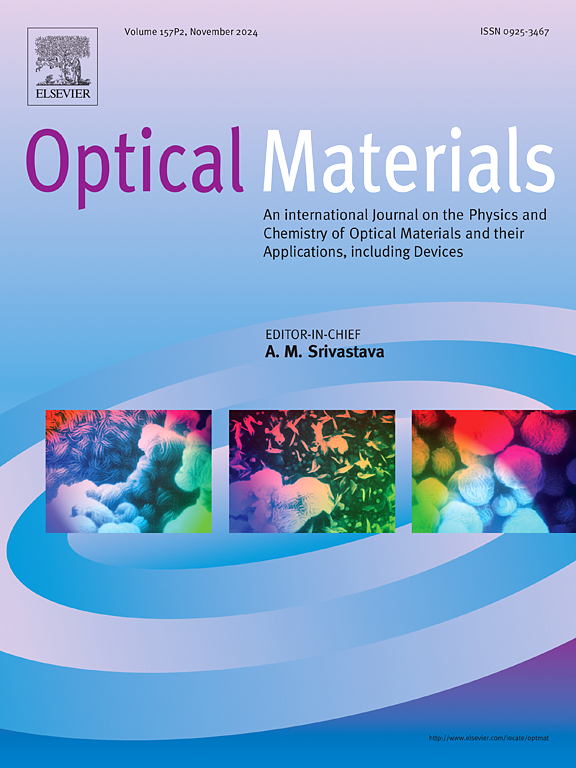伽玛射线诱导的Ga2-xEuxO3荧光粉在恶劣辐射环境中的红光发射增强
IF 4.2
3区 材料科学
Q2 MATERIALS SCIENCE, MULTIDISCIPLINARY
引用次数: 0
摘要
通过固相反应制备了Eu3+掺杂β-Ga2O3 (Ga2-xEuxO3, x = 0.01 ~ 0.06, Δx = 0.01)红色荧光粉。在暴露于2 Mrad剂量的伽马射线照射之前和之后,对光致发光(PL),表面形貌,三维轮廓,晶体结构和x射线光电子能谱进行了深入分析。PL结果显示,伽马射线辐照样品的发光强度明显高于其对应物。值得注意的是,对于5% Eu3+掺杂浓度的样品,在394 nm激发下,红色发射的发光强度在613 nm处达到峰值,辐照后的发光强度增加了14.5±1%。这一现象挑战了高能辐射总是会降低光学性能的传统观点。我们证明了伽马射线会产生有益的缺陷(例如氧空位和晶格畸变),从而抑制非辐射复合并增强Eu3+发射。此外,Ga2-xEuxO3样品在高达2 Mrad剂量的伽马射线辐射下表现出显著的耐久性,这相当于近80年来近地轨道卫星所经历的累积辐射剂量。这些光学和结构性质表明,Eu3+掺杂Ga2O3是一种有前途的在恶劣辐射环境中应用的红色磷光材料。本文章由计算机程序翻译,如有差异,请以英文原文为准。
Gamma-ray-induced enhancement of red emission in Ga2-xEuxO3 phosphors for harsh radiative environment applications
Eu3+-doped β-Ga2O3 (Ga2-xEuxO3, x = 0.01–0.06, Δx = 0.01) red phosphors were fabricated in cylindrical pellet shape via the solid-state reaction route. An in-depth analysis of photoluminescence (PL), surface morphology, three-dimensional profiles, crystal structure, and X-ray photoelectron spectroscopy spectra has been carried out both before and following exposure to a 2 Mrad dose of gamma-ray irradiation. The PL results revealed that gamma-ray-irradiated samples have significantly higher luminescence intensity compared to their counterparts. Notably, for the sample with a 5 % Eu3+ doping concentration, the luminescence intensity of the red emission, which peaks at 613 nm under 394 nm excitation, increased by 14.5 ± 1 % after irradiation. This phenomenon challenges the conventional wisdom that high-energy radiation always degrades optical properties. We demonstrate that gamma rays create beneficial defects (e.g. oxygen vacancies and lattice distortions) that suppress non-radiative recombination and enhance Eu3+ emission. Additionally, the Ga2-xEuxO3 samples demonstrated remarkable durability to gamma-ray radiation up to a dose of 2 Mrad, which corresponds to the cumulative radiation dose experienced by satellites in low-Earth orbit over nearly 80 years. These optical and structural properties suggest that the Eu3+-doped Ga2O3 is a promising red phosphorescent material for applications in harsh radiative environments.
求助全文
通过发布文献求助,成功后即可免费获取论文全文。
去求助
来源期刊

Optical Materials
工程技术-材料科学:综合
CiteScore
6.60
自引率
12.80%
发文量
1265
审稿时长
38 days
期刊介绍:
Optical Materials has an open access mirror journal Optical Materials: X, sharing the same aims and scope, editorial team, submission system and rigorous peer review.
The purpose of Optical Materials is to provide a means of communication and technology transfer between researchers who are interested in materials for potential device applications. The journal publishes original papers and review articles on the design, synthesis, characterisation and applications of optical materials.
OPTICAL MATERIALS focuses on:
• Optical Properties of Material Systems;
• The Materials Aspects of Optical Phenomena;
• The Materials Aspects of Devices and Applications.
Authors can submit separate research elements describing their data to Data in Brief and methods to Methods X.
 求助内容:
求助内容: 应助结果提醒方式:
应助结果提醒方式:


